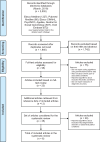Validity of Algorithms for Identification of Individuals Suffering from Chronic Noncancer Pain in Administrative Databases: A Systematic Review
- PMID: 32142130
- PMCID: PMC7553015
- DOI: 10.1093/pm/pnaa004
Validity of Algorithms for Identification of Individuals Suffering from Chronic Noncancer Pain in Administrative Databases: A Systematic Review
Abstract
Background: Secondary analysis of health administrative databases is indispensable to enriching our understanding of health trajectories, health care utilization, and real-world risks and benefits of drugs among large populations.
Objectives: This systematic review aimed at assessing evidence about the validity of algorithms for the identification of individuals suffering from nonarthritic chronic noncancer pain (CNCP) in administrative databases.
Methods: Studies reporting measures of diagnostic accuracy of such algorithms and published in English or French were searched in the Medline, Embase, CINAHL, AgeLine, PsycINFO, and Abstracts in Social Gerontology electronic databases without any dates of coverage restrictions up to March 1, 2018. Reference lists of included studies were also screened for additional publications.
Results: Only six studies focused on commonly studied CNCP conditions and were included in the review. Some algorithms showed a ≥60% combination of sensitivity and specificity values (back pain disorders in general, fibromyalgia, low back pain, migraine, neck/back problems studied together). Only algorithms designed to identify fibromyalgia cases reached a ≥80% combination (without replication of findings in other studies/databases).
Conclusions: In summary, the present investigation informs us about the limited amount of literature available to guide and support the use of administrative databases as valid sources of data for research on CNCP. Considering the added value of such data sources, the important research gaps identified in this innovative review provide important directions for future research. The review protocol was registered with PROSPERO (CRD42018086402).
Keywords: Accuracy; Administrative Databases; Algorithms; Back Pain; Chronic Pain; Claims; Complex Regional Pain Syndrome; Diagnostic Codes; Fibromyalgia; Headache; Migraine; Neck Pain; Neuropathic Pain; Sensitivity; Specificity; Validity.
© 2020 American Academy of Pain Medicine.
Similar articles
-
Is the Quebec provincial administrative database a valid source for research on chronic non-cancer pain?Pharmacoepidemiol Drug Saf. 2015 Sep;24(9):980-90. doi: 10.1002/pds.3820. Epub 2015 Jun 24. Pharmacoepidemiol Drug Saf. 2015. PMID: 26105572
-
Beyond the black stump: rapid reviews of health research issues affecting regional, rural and remote Australia.Med J Aust. 2020 Dec;213 Suppl 11:S3-S32.e1. doi: 10.5694/mja2.50881. Med J Aust. 2020. PMID: 33314144
-
A Systematic Review of Case-Identification Algorithms Based on Italian Healthcare Administrative Databases for Two Relevant Diseases of the Endocrine System: Diabetes Mellitus and Thyroid Disorders.Epidemiol Prev. 2019 Jul-Aug;43(4 Suppl 2):17-36. doi: 10.19191/EP19.4.S2.P008.089. Epidemiol Prev. 2019. PMID: 31650804
-
The validity of diagnostic algorithms to identify asthma patients in healthcare administrative databases: a systematic literature review.J Asthma. 2022 Jan;59(1):152-168. doi: 10.1080/02770903.2020.1827425. Epub 2020 Oct 15. J Asthma. 2022. PMID: 32990481
-
Accuracy and utility of using administrative healthcare databases to identify people with epilepsy: a protocol for a systematic review and meta-analysis.BMJ Open. 2018 Jun 30;8(6):e020824. doi: 10.1136/bmjopen-2017-020824. BMJ Open. 2018. PMID: 29961014 Free PMC article.
Cited by
-
Chronic pain patients' willingness to share personal identifiers on the web for the linkage of medico-administrative claims and patient-reported data: The chronic pain treatment cohort.Pharmacoepidemiol Drug Saf. 2021 Aug;30(8):1012-1026. doi: 10.1002/pds.5255. Epub 2021 May 4. Pharmacoepidemiol Drug Saf. 2021. PMID: 33901339 Free PMC article.
-
Chronic pain is a risk factor for incident Alzheimer's disease: a nationwide propensity-matched cohort using administrative data.Front Aging Neurosci. 2023 Sep 28;15:1193108. doi: 10.3389/fnagi.2023.1193108. eCollection 2023. Front Aging Neurosci. 2023. PMID: 37842123 Free PMC article.
-
Antiepileptic prescribing to persons living with dementia residing in nursing homes: A tale of two indications.J Am Geriatr Soc. 2023 Jan;71(1):89-97. doi: 10.1111/jgs.18119. Epub 2022 Nov 9. J Am Geriatr Soc. 2023. PMID: 36349528 Free PMC article.
-
New data-driven method to predict the therapeutic indication of redeemed prescriptions in secondary data sources: a case study on antiseizure medications users aged ≥65 identified in Danish registries.BMJ Open. 2024 Jun 6;14(6):e080126. doi: 10.1136/bmjopen-2023-080126. BMJ Open. 2024. PMID: 38844392 Free PMC article.
-
Opioid analgesics for chronic noncancer pain in patients prescribed opioid agonist therapy or with opioid use disorder: A systematic review.Can J Pain. 2025 Jul 31;9(1):2499553. doi: 10.1080/24740527.2025.2499553. eCollection 2025. Can J Pain. 2025. PMID: 40761412 Free PMC article. Review.
References
-
- Schneeweiss S, Avorn J.. A review of uses of health care utilization databases for epidemiologic research on therapeutics. J Clin Epidemiol 2005;58(4):323–37. - PubMed
-
- Tamblyn R, Lavoie G, Petrella L, Monette J.. The use of prescription claims databases in pharmacoepidemiological research: The accuracy and comprehensiveness of the prescription claims database in Quebec. J Clin Epidemiol 1995;48(8):999–1009. - PubMed
-
- Strom BL, Kimmel SE, Hennessy S.. Pharmacoepidemiology. 5th ed.Sussex: Wiley-Blackwell; 2012.
-
- Bernatsky S, Lix L, O’donnell S, Lacaille D.. Consensus statements for the use of administrative health data in rheumatic disease research and surveillance. J Rheumatol 2013;40(1):66–73. - PubMed
Publication types
MeSH terms
Substances
Grants and funding
LinkOut - more resources
Full Text Sources
Medical


